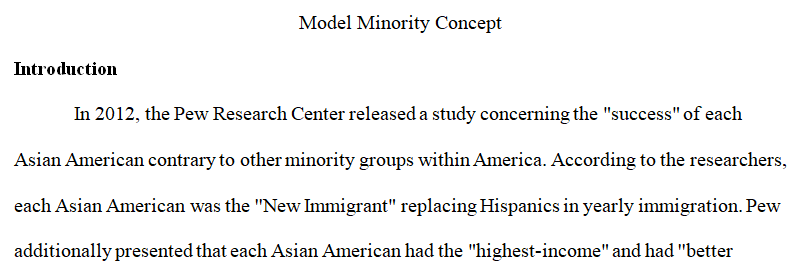
Develop and support a cohesive argument that recognizes and accounts for the historical complexity
Model Minority Concept
Please follow the instructions carefully, use at least six documents provided and cite them clearly(include the document #)
Instructions:
To complete the final exam, you will write a standard long format essay (at least 1000 words, 5-6, pages, 12 point Times New Roman font, double space) to answer the following prompt:
- Discuss, define, and explain the origins, evolution, and the complexities of the model minority concept.
Your essay will need to take into consideration the following documents:
| Document #1: “Mr. Sing Sheng Placed a bet on American democracy and lost it. In Asia they will therefore be asking whether American democracy is worth betting on. It still is… The response to the Sheng case has been strong and nationwide. Other cities have offered him a job and a home…That is one minor count for American democracy. Another is the fact that sheng could have moved into the Southwood house if he had wanted to make an issue of it. The restrictive covenant is legally unenforceable; so says the Supreme Court. But Sheng made what is calls a “gentleman’s agreement” to abide by the outcome of the balloting. In other words, he tactfully asks more of our democracy than law can provide… In fact the people of Southwood were less prejudiced against the Sheng than against losing money. The market value of group prejudice is the key to the segregation problem in the U.S. During the last 10 years, the U.S. has made revolutionary progress toward racial equality. If this progress continues, prejudice should eventually even lose its market value. It had better, for the national cost of discrimination are exceedingly high…According to the Urban League the total economic cost of discrimination in a city like New York is at least 1 billion dollars per year. [The national cost of discrimination] is at least as real as the one the calculating householders of Southwood think they have avoided. When we outgrow group prejudice in the country, the Southwood type of property loss would be inconceivable, and the present cost of discrimination will be turned into big gain for all.” Document #1: Life Magazine Condemns Southwood’s Denial of Housing to Sing Sheng (1952) |
| Document #2: Document #2: Imperial Japan Propaganda during World War 2 |
| Document #3: Document #3: George Isoda in front of the fire place, photo by the War Relocation Authority (Links to an external site.) |
| Document #4 Document #4: “Nisei in Uniform” by the War Relocation Authority (Links to an external site.) |
| Document #5 Document #5: “Chinatown Offers Us a Lesson” by William A. McIntyre, New York Times, 1957 (link for full article) |
| Document #6: “Success Story, Japanese American Style” by William Petersen, New York Times (1966) |
| Document #7: “Success Story of One Minority Group in U.S.” by the U.S. News & World Report (1966) |
| Document #8: Document #8: Education Data on Asian Pacific Americans by National Commission on Asian American and Pacific Islander Research in Education (2011) |
Your grade (250 points) for this assignment will be based on the following criteria:
- Thesis:Present a thesis that makes a historically defensible claim and response to all parts of the question. Your thesis must consist of one or more sentences located in the introduction.
- Argument Development: Develop and support a cohesive argument that recognizes and accounts for the historical complexity by explicitly illustrating relationships among historical evidence such as contradictions, corroboration, and/or qualification.
- Use of Documents: Utilize the content of at least six of the documentsto support the stated thesis or a relevant argument. For every document below the minimum of six document quota, 30 points will be deducted from your total score.
- Sourcing the documents:Explaining the significance of the author’s point of view, author’s purpose, historical context, and/or audience for at least six documents.
- Contextualization:Situate the argument by explaining the broader historical events, developments, or processes immediately relevant to the question.
- Outside Evidences:Provide examples or additional evidence (key terms/concept from the reading and class lectures) beyond those found in the documents to support your argument.
[Double Check Your Submission] double-check your submission to make sure it meets all of the criteria for the assignment.
- [Proofread]Please proofread your essay utilizes at least six documents to answer the essay prompt in a clear, organized, detailed, and cohesive essay format (short essay response includes a short introduction including a thesis statement, body paragraphs with supporting evidence, and conclusion statement)
- [At least 1000 words] Your submission must be at least 1000 words and include specific details, key terms, and contents from class readings and lectures. Any submission with fewer than 1000 words will automatically receive a zero
- [Include citations of at least six documents]When quoting or citing from document, a simple in writing MLA citation (source #) at the end of the sentence is sufficient. Any essay that does not include a citation of assigned documents and discuss relevant information/content beyond the documents and written in a vague and broad manner will not receive partial credit
16 hours ago
REQUIREMENTS
4 pages, Double Spacing San Jose State University
History,
Answer preview………………………
 apa 1250 words
apa 1250 words